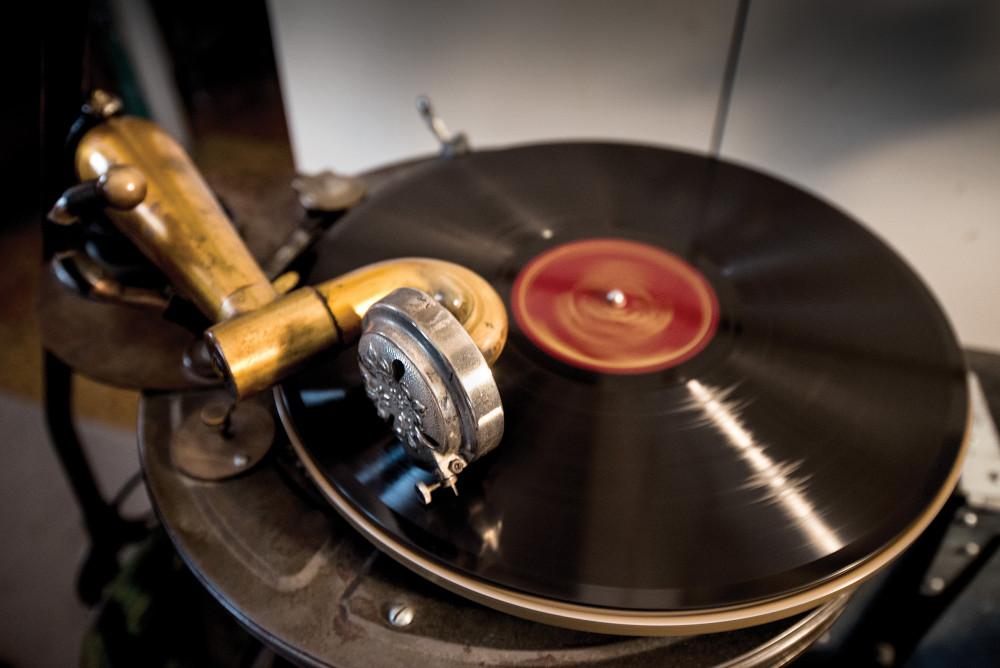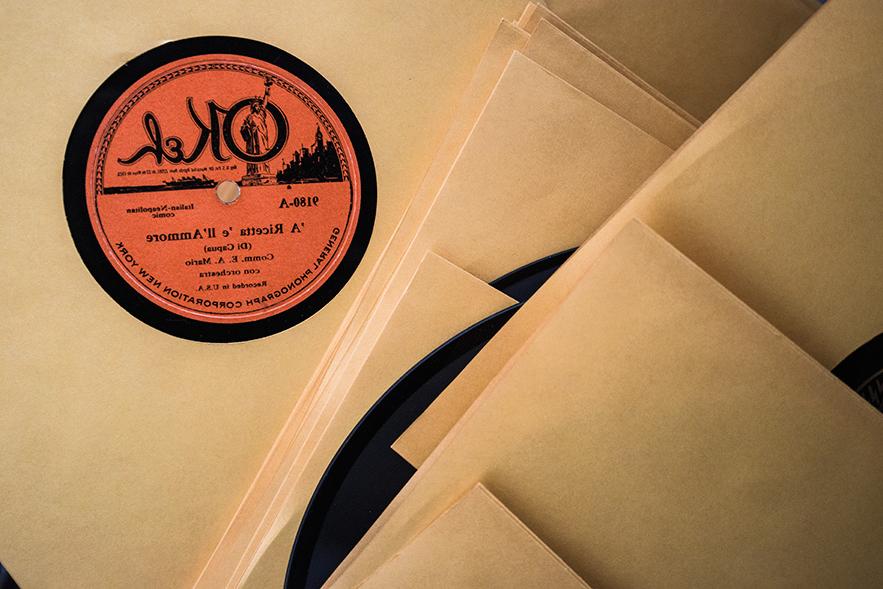复古的维.J.
这个引人注目的装置的所有者和创造者, 埃里克·拜伦70年, 是档案管理员吗, 作者, 也是早期录音爱好者. 大约十年来每个愉快的星期天, 他拿出这台200磅重的留声机, 被称为“大角”,是他亲手制作的, 距离他下东区的公寓一英里. 他和D带来了大约100张唱片.J.’d selections from his archive of 78s from the early 1900s—playing everything from jazz to opera to popular works. 好奇的人停下来听一听,有些常客一听就是几个小时.
拜伦, 现在是埃利斯岛唱片项目的创始人和协调员, 1957年9岁时制作了他的第一部留声机, 他摔断了腿,只能坐在轮椅上. 他在看先生。. 《菠菜白菜吧》是一档面向儿童的科学电视节目,在他位于纽约州东梅多的家中播出.Y., 当时有一集提供了如何用一套安装工具制作留声机的说明, 海报板, 还有一个帽针. 把这些放在一起之后, 他在家中制造了更多的手摇留声机,并找到了一些物品. 有东西可以玩, 拜伦开始在跳蚤市场和旧货店寻找78s的旧唱片. 一种激情就此诞生.
差不多在同一时间, 拜伦 began to get involved with local preservation and archaeology—a different kind of historical observing—working with a friend to successfully save a building. 高中时,他在长岛当地的一个考古遗址工作. These interests led him to 贝洛伊特, known for its archaeologists and anthropology program. He switched his major to general anthropology and soon discovered things he had never tried before—like folk dancing and sculpture, 他很喜欢. 他曾在加拿大和以色列学习. 在智力上,伯洛伊特让他大吃一惊:“存在主义——所有的一切,哇,哇,哇!他说. “我可以开始把所有这些东西应用到我对世界的问题上.”
Even after graduation, he kept coming back to 贝洛伊特, ping-ponging from Boston to Wisconsin twice. “贝洛伊特是我生命中最美好的部分,”他说. “我喜欢它。. I wish they had an old age section of the college because I think many of us would come back.”
但最终,他降落在了纽约市,并在那里住了下来. 他对学习意第绪语的渴望, 部分灵感来自他说意第绪语的外祖母, 他在波士顿的表现不太好吗. 但在纽约,他遇到了合适的资源. He took courses in the 犹太人 language and culture at Columbia University and Queens College, 参加了纽约大学博物馆研究课程, and did graduate work at Hunter College that culminated in a master’s degree from Goddard College.
He applied all of this to various anthropological and archaeological work in New York. 在20世纪80年代,拜伦在职业生涯中遇到了毁灭性的困难. 他说:“我摆脱困境的方法之一就是开始做东西。. He made art that sold, and he created several wind-up phonographs, including Big Horn. Former 贝洛伊特ers helped him—the couple Charles 坎特’71 and Carol Greenwald’73 wrote a $100 check to help cover expenses for putting the machine together. 和, when he was trying to figure out how his wagon could move smoothly along New York’s bumpy sidewalks, 坎特, 谁叫大角?, 提出充气轮胎可能会有所帮助. “他的建议改变了一切,”拜伦说. 作为公园常客, Big Horn received coverage from National Public Radio and was the subject of a Funky Winkerbean comic.

其次,这些录音中有许多对种族并不敏感. 早期的专辑最初是针对美国白人的, 后来又迎合了流入这个国家的新移民.
通常更少, 那些immigrants-Italian, 犹太人, 爱尔兰, 而且更多的是为这一类型做出了贡献, 有时将母语与英语混合. The friction of these cultures colliding resulted in some recordings that brimmed with racial, class, and ethnic stereotypes; many were downright racist. 在他的书的序言里, 打开留声机:早期录音中的我们是谁,我们从哪里来, 拜伦写道:“那是一个美国人畅所欲言的时代, 他们的很多想法都出现在了早期的录音中.”
他们认为这是相当激烈的. One album was so racist that the first time he heard it, 拜伦 took the arm off the record. “然后我把它放回去,因为我想听剩下的,”他说. “I got over ‘these are offensive’ and I wanted to know what was going on—why were these being done the way they were? 和 why did you sometimes have individuals from the very group that was being mocked doing the performing?作为一名学者和历史学家,他开始听这些录音. 他指出,即使是欧文·柏林——美国作曲家, 抒情诗人, and 犹太人 immigrant from Russia—included equally offensive songs in his oeuvre around the same time like, "嘿,哎哟"和"科恩欠我97美元.”
不过,并不是所有的录音都很粗糙. Some were soap operatic love stories or goofy 喜剧—and they all offered a window onto American entertainment before radio was big and before television existed, 在旧世界向“新世界”涌入的过程中.“拜伦, 他总是对他的犹太移民祖父母很感兴趣, 发现这项研究特别迷人和令人振奋. 他说:“开始做这件事让我重获新生。.
当拜伦开始在埃利斯岛国家移民博物馆做志愿者时, 他正式开始研究录音. In 1993, 博物馆聘请他为博物馆技术员, 几年后, he started working on the Ellis Island Discography Project—an archive he created and continues to run. He and his team find recordings about and by the “outsider,” cataloguing them in a database. 到目前为止,他们已经记录了8700多个. 大约70名志愿者为这个项目贡献了数千小时.
Judy Giuriceo, curator of exhibits at Ellis Island, attests to the power of this collection. “The discography database that Eric 拜伦 has created is an invaluable resource for both scholars and the general public,她说。. 早期的录音是记录这种希望的主要来源, 恐惧, 愿望, 疼痛, 幽默, 以及新移民的挣扎.”
在他的书中, 拜伦注意到1900年到1950年间, 美国公司至少生产了30种,针对外国出生社区的000张78转记录. Collecting and studying these albums is “creating an opportunity to understand cultural patterns beyond the content of individual recordings,他写道。. 例如, he and his team analyze words repeated in many of the songs to gain insight into the daily experiences of those landing in a strange land at that time. 一些移民的录音是母语和英语的混合, 然而,某些英语单词反复出现. 经常出现的短语和单词是:工作、警察、寄宿生和闭嘴. Because each album ran only about two to four minutes, every word was chosen with care. 拜伦和其他人仍在努力了解它们究竟揭示了什么.

这些天, the Lower East Side is full of power brokers blasting digital music into their ears via headphones. Yet 拜伦 and others are still actively working on this auditory archaeology—unearthing voices from that busy, 不确定的, 充满希望的时间. New recordings come in regularly that need to be logged and/or translated from Yiddish and other languages. It’s 拜伦’s fervent desire that his work collecting these “outsider” recordings continues on, 即使在他走后.
“埃里克很敬业。, 心灵与思想, 通过埃利斯岛来到这里的移民的历史和物质文化, 尤其是那些后来在纽约定居的人,他的同事朱里塞奥说. “和他一起工作也很愉快——很有兴趣, 有趣的, 热情的, 对他的知识也很慷慨.”
由于关节炎, 拜伦 can no longer add to his home-based collection of the 10 or so remaining wind-up phonographs he’s made or collected but hasn’t given away—including Big Horn and a small one made from a candy box and a piece of mica. 但他经常听他收藏的1500张左右的唱片. 68岁时, 他的手指不那么灵活, yet his passion and curiosity for these recordings and the populations from which they sprung pulse unabated. 他说:“当我还是个孩子的时候,我想我可以了解这一切。. “现在我是成年人了,我不知道. 但它仍然很吸引人.”
95届的瓦莱丽·赖斯是土生土长的纽约人, 作家, 编辑器, 瑜伽从业者, 妈妈现在住在马萨诸塞州西部.
哦,泥封
美国唱片公司至少制作了30首,1900年至1950年间针对移民社区的流行录音. 埃里克·拜伦70年 is fascinated by what they can still tell us about the lives of these new Americans. 这是Stan Boreson的“The Lutefisk Song”的节选,拜伦写道, “juxtaposes praise and derision on what Norwegians obviously deem an important dish made from fish.”
哦,琵琶鱼,哦,琵琶鱼,你的香气多么芬芳.
哦,鱼,鱼,你让我昏迷了.
你闻起来很浓,像胶水一样.
但是鱼——星期六来吧,我想我还是要吃了你.


